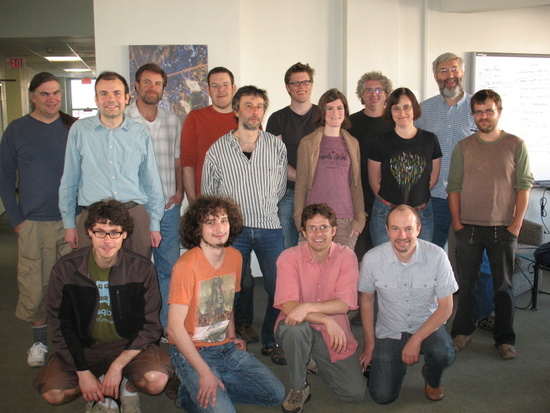NCEAS Working Groups
Establishing an open-source animal-tracking analysis platform for archival geolocators
Project Description
For centuries, naturalists have wondered how small migratory birds move between breeding sites and wintering locations, but our ability to study songbird migration has been limited by the logistical challenge of tracking tiny birds that fly thousands of kilometers. In just the past few years, researchers have been experimenting with a new tracking device that can revolutionize our understanding of migration by determining the migration routes of individual song birds. This key innovation is called an electronic tracking device called a geolocation datalogger (or geologger), which has recently been miniaturized to a mass of 0.5 grams—small enough to deploy on birds weighing around 10 grams. Geologgers work by logging light levels at regular intervals such that one can determine the duration of the daylight period (day length) and the midpoint between sunrise and sunset (solar noon). With these two bits of information from each day the bird wears the tag, we can estimate latitude from day length and longitude from the time of solar noon. Although there is great potential for this tracking technique, it is problematic at times, because shading during twilight events (caused by environmental factors or bird behavior) can greatly influence location estimates. Moreover, latitude estimates are nearly impossible during the equinoxes, when day length is 12 hours the world over. Numerous solutions to these problems have been proposed and implemented in a variety of disconnected analysis tools, most of which are extremely difficult to implement. The Animal-Tracking Analysis Working Group will consolidate the most promising of these analysis tools into a single analysis package that is linked to a simple point-and-click web-based interface. The group will also promote sharing of scientific data by linking the interface to open-access data archives, such that using the analysis tools will entail the generation of data sets that can be made accessible to the general public. Membership of the working group consists of programmers who have written movement analysis software, field biologists with real-world data to analyze, and administrators and data curators of ecological data archives. Our meetings will not only result in the best possible analysis software but will promote individual research projects and multi-project collaborations among the working group members.

Principal Investigator(s)
Eli S. Bridge, Eldar Rakhimberdiev, Nathaniel E. Seavy, David W. Winkler
Project Dates
Start: December 1, 2012
End: September 30, 2013
completed
Participants
- Eli S. Bridge
- University of Oklahoma
- Sarah C. Davidson
- Max-Planck Institute for Ornithology
- Philip Dow
- University of Oklahoma
- Jonah M. Duckles
- University of Oklahoma
- Steffen Hahn
- Swiss Ornithological Institute
- Jeffrey Hostetler
- Smithsonian Conservation Biology Institute
- Simeon Lisovski
- Deakin University
- Eldar Rakhimberdiev
- Royal Netherlands Institute for Sea Research (NIOZ)
- James Regetz
- University of California, Santa Barbara
- Heiko Schmaljohann
- Institute of Avian Research
- Nathaniel E. Seavy
- Point Blue Conservation Science (formally Point Reyes Bird Observatory (PRBO))
- Michael D. Sumner
- University of Tasmania
- Caroline M. Taylor
- Tulane University
- David W. Winkler
- Cornell University
- Simon Wotherspoon
- University of Tasmania
- Michael Wunder
- University of Colorado
Products
-
Presentations / 2013
A simple online tool for geolocater analysis
-
Journal Article / 2015
Do molt-migrant songbirds optimize migration routes based on primary productivity?
-
Journal Article / 2019
Light-Level Geolocator Analyses: A user's guide
-
Journal Article / 2015
A hidden Markov model for reconstructing animal paths from solar geolocation loggers using templates for light intensity
